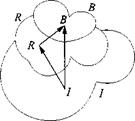Transformations
Observing in the night sky a satellite still illuminated by the sun and an airplane flashing its strobe light, one may get the impression that both stay aloft by the same forces. However, we know better. Aerodynamic forces carry the airplane, but what holds up the satellite? You would answer, “the centrifugal force of course!” What is that centrifugal force? Is it a surface force, like aerodynamic lift, or a volume force, like gravity? Is it a force that should be included at the right-hand side of Newton’s law? None of the above. It is all a matter of reference frame. Because you are not standing on an inertial reference frame, an apparent force, the centrifugal force, keeps the satellite from falling at your feet. However, if you were sitting on the ecliptic, you would marvel how the Earth’s gravitational pull prevents the satellite from escaping the Earth’s orbit.
Both observations are equally valid. So far we have taken the inertial perspective. Now I will derive the translational equations of motion for noninertial reference
|
Fig. 5.7 Reference frame R. |
frames. Besides the centrifugal force, we shall also encounter the Coriolis force, which gives this transformation its name.
Another situation arises when the c. m. is not the preferred reference point. Envision a large symmetrical space station with antennas on one side as appendages. It is sometimes advantageous to use the c. m. of the space station as reference point for the dynamic equations, rather than the common c. m. This point transformation is called the Grubin transformation.












